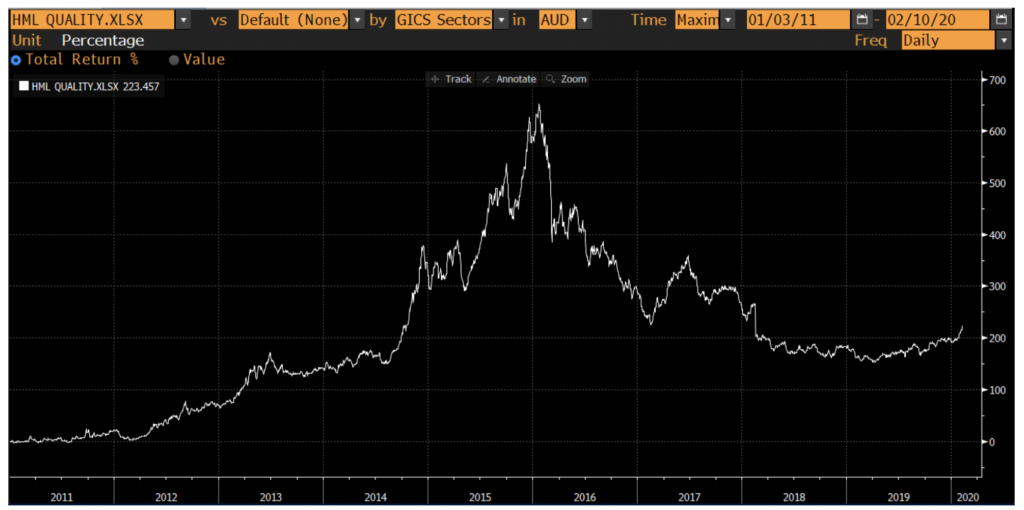
Are quality businesses set to shine again?
Some years ago, we put together a notional “High-minus-low quality” portfolio, which holds long positions in ASX-listed companies that we consider to be high-quality, and short positions in companies that we consider to be lower-quality. The absolute return from this portfolio provides an indication of whether the higher quality companies are outperforming the lower-quality companies.
It should be noted that in the Australian market, this portfolio largely aligns itself along sectoral lines, with natural resources companies tending to be plentiful in the short portfolio and scarce in the long portfolio. However, it also provides a reasonable measure of the “quality” dimension that guides portfolio construction for The Montgomery Fund and the Montgomery [Private] Fund.
Over long periods of time we expect higher-quality companies to do better than lower-quality companies, and so we expect that the portfolio should trend upwards on average, but this is a long-term average. Along the way there will be times when it rises very strongly, and times when it falls just as strongly.
For example, the years leading up to the end of 2015 were a golden age for quality, with the notional portfolio rising consistently year after year. This also coincided with a run of stellar relative performance for The Montgomery Fund and the Montgomery [Private] Fund.
However, early in 2016, the tide turned sharply, and quality entered a multi-year period of underperformance, largely driven by resources companies rallying strongly. The story is a bit more complicated than this, and some high-quality businesses have certainly performed well recently, but on average, investors who commit to only owning high-quality companies (at least as we define them) found this period to be a challenging one. In the case of The Montgomery Fund and the Montgomery [Private] Fund it certainly coincided with a significant period of weak relative performance.
The chart below maps the progress of the “High-minus-low” notional quality portfolio over time, and we think that something interesting may be emerging.
Performance of HML Quality Portfolio

Source: Bloomberg
After several years of quality headwinds, it appears that the tide may again have turned, with the notional portfolio indicating a subtle, but consistent recovery commencing in 2019.
It is probably no coincidence that after several years of underperformance, The Montgomery Fund and the Montgomery [Private] Fund are also showing some healthy relative performance numbers for the financial year to date.
We can’t say with any confidence whether the quality downturn has indeed bottomed, or whether we might feel a quality tailwind or a headwind in the months ahead. However, we can say with some confidence that we expect quality companies to outperform over the long run, and that patient investors who can weather the ups and downs should benefit from this.
In addition, with three years of relative underperformance for quality now behind us, high quality may now be offering a relatively appealing value proposition compared with low quality.